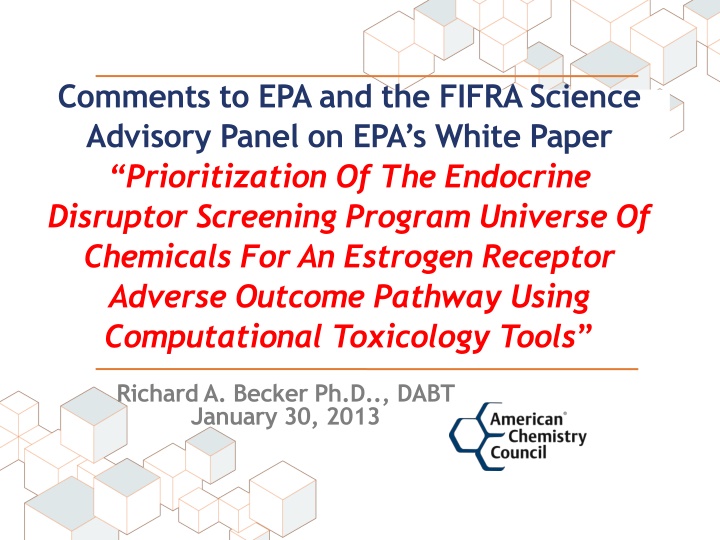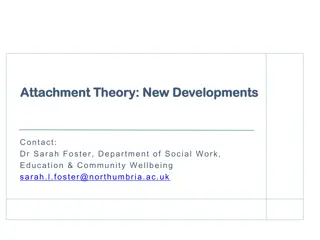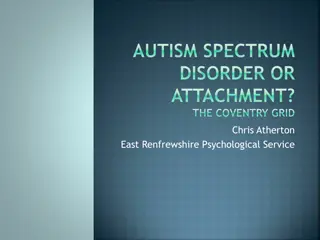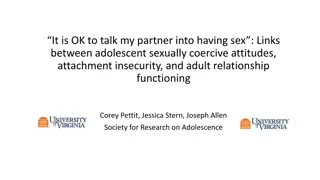
Improving Prioritization in Endocrine Disruptor Screening Program
Supporting EPA's research efforts to enhance scientific tools for the EDSP, this feedback addresses the need for continued progress in prioritization, screening, and testing using computational toxicology tools. Comments highlight the importance of integrating different programs, establishing scientific confidence in assays, and ensuring transparency in prediction models.
Download Presentation

Please find below an Image/Link to download the presentation.
The content on the website is provided AS IS for your information and personal use only. It may not be sold, licensed, or shared on other websites without obtaining consent from the author. If you encounter any issues during the download, it is possible that the publisher has removed the file from their server.
You are allowed to download the files provided on this website for personal or commercial use, subject to the condition that they are used lawfully. All files are the property of their respective owners.
The content on the website is provided AS IS for your information and personal use only. It may not be sold, licensed, or shared on other websites without obtaining consent from the author.
E N D
Presentation Transcript
Comments to EPA and the FIFRA Science Advisory Panel on EPA s White Paper Prioritization Of The Endocrine Disruptor Screening Program Universe Of Chemicals For An Estrogen Receptor Adverse Outcome Pathway Using Computational Toxicology Tools Richard A. Becker Ph.D.., DABT January 30, 2013
Improving Prioritization We support EPA s research efforts to develop improved scientific tools for EDSP: prioritization, screening and testing Considerable progress has been made, but more needs to be done To date efforts have concentrated on QSAR, Expert System and HTP screening Risk-based prioritization will require a similar focus on indices of exposure
General Comments The ER Expert System and the ToxCast HTP activities reflect separate programs An attempt has been made to marry these up But they are clearly not adequately integrated yet . the general nature of the charge questions can lead to very general recommendations
Establishing Scientific Confidence in Assays and Prediction Models (1) Need to understand reliability, sensitivity and specificity of assays Data to evaluate performance needs to be generated using appropriate set of substances in the suite of assays rec. ICCVAM 2006 list for ER assays
Establishing Scientific Confidence in Assays and Prediction Models (2)
Establishing Scientific Confidence in Assays and Prediction Models (3) Discuss application of / adapting OECD QSAR Principles to HTP assays & prediction models Discuss modifying the IOM Qualifying Biomarkers framework as another approach that can be adapted Discuss Adverse Outcome Pathways (AOPs) from a conceptual perspective
Establishing Scientific Confidence in Assays and Prediction Models (4) Transparency in the prediction model algorithms is a necessity all steps, filters, decision points, etc. and data sets used in analyzing performance The ER Expert System is good example of working towards transparency HTP models shouldn t be black boxes All of the relevant data, model construct components, rep. model runs to demonstrate performance need to be available Peer reviews and other experts shouldn t have to reverse engineer the models to independently evaluate performance and conduct sensitivity analyses
Suggestions Develop a Road Map to Guide EPA Provide a road map that the Agency can follow to conduct the studies and analyses needed to establish the scientific confidence in assays and prediction models for their intended uses For prediction model transparency use open source principles with respect to model structures, applications, analyses, user guide, etc. This will enable peer reviewers and other qualified experts to fully follow each and every step, understand rationales, conduct model runs & sensitivity analysis independently, etc.
Figure from: Patlewicz et al.. Use and Validation of HT/HC Assays to Support 21st Century Toxicity Evaluations (2013) The Exposure- Effect Discontinuum 1. The Molecular Initiating Event (MEI) of an AOP should more aptly be called the Initial Molecular Event (IME), because although it may be the first biological response event in the pathway, it does not necessarily initiate a chain of events that automatically leads to adverse effects. Response is dependent on the potency of a substance, the magnitude, frequency duration of dose and sensitivity of the test system / organism. Not all exposures will produce adverse effects, even when measur- able responses are detected in the Molecular Initiating Event. Understanding dose-related events and dose-dependent transitions at the biochemical, cellular, organ, organismal, and population levels will lead to improvements in prediction models based on Adverse Outcome Pathways. 2. 3. Adverse Health Outcome Higher Dose Leads to Altered Organ Structure / Function 4. Diminished Capacity or May Be Reversible and No Adverse Outcomes Higher Dose Leads to Altered Organ Structure / Function Higher Dose Leads to Altered Physiology: Adaptive Response No Adverse Outcomes Increasing Dose Higher Dose Elicits Homeostatic Response No Adverse Outcome Typical AOP IMEs Used in HT/HC Assays Chemical Properties Protein binding DNA Binding Receptor Binding Gene Expression Protein Production Altered Signaling Dose Below Threshold No Adverse Outcomes Interaction with macromolecules Organism Responses and Population Effects Toxicant Cellular Responses Organ Effects Adverse Outcome Pathway






















